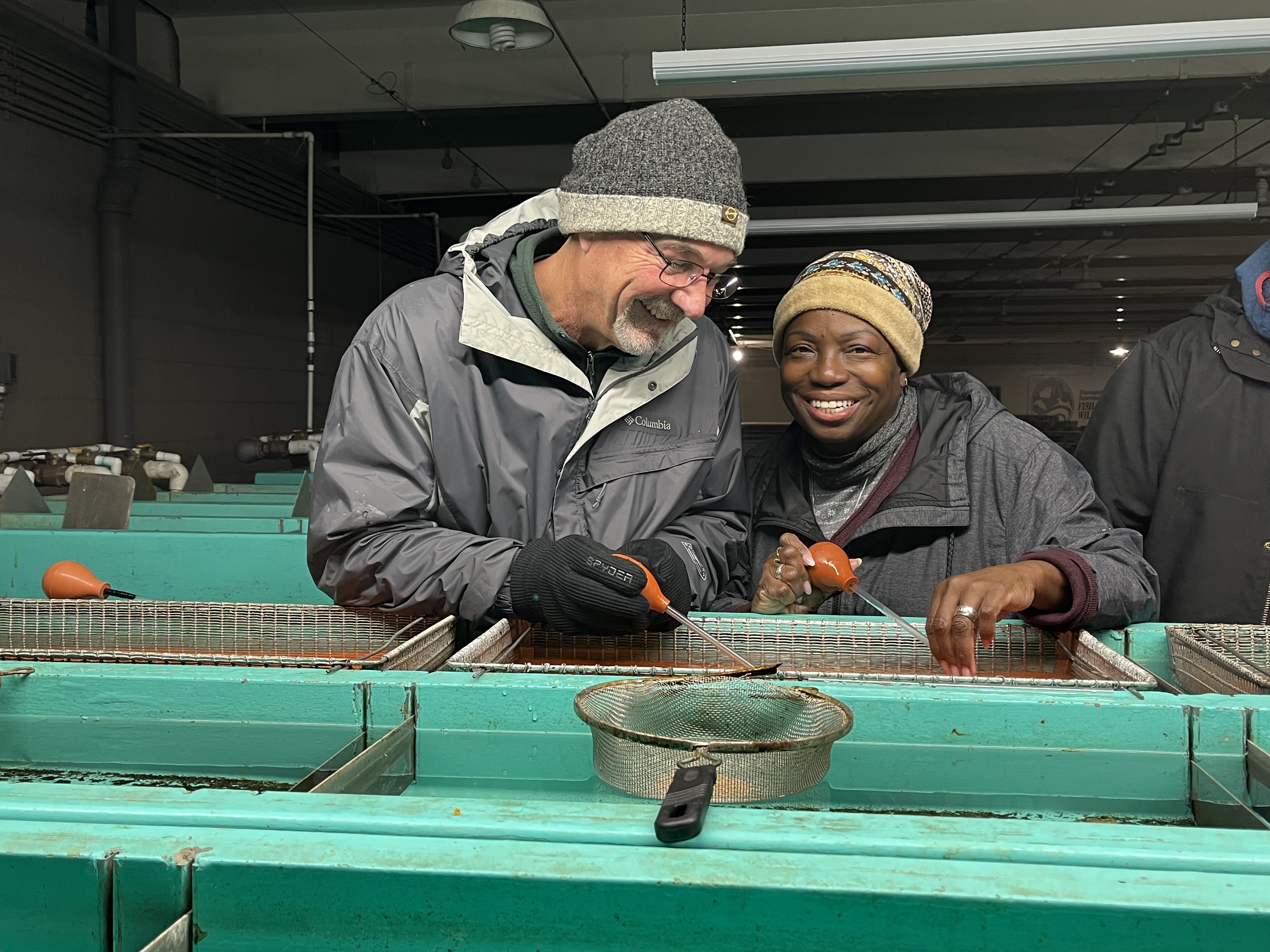Calling the Salmon Home
May 30, 2025
May 30, 2025
By Heidi Lasher, Conservancy Volunteer
In midsummer, paddlers representing tribes from the Upper Columbia River watershed traveled 100 miles in dug-out canoes and kayaks to the flooded shores of Kettle Falls. Hundreds of friends and family members gathered to welcome them and to call the salmon home.
For 80 years, not a single salmon or steelhead has swum its way into the Upper Columbia River to spawn. Yet the tribes of the upper Columbia have never stopped calling them home.
In the Spokane River, salmon migration ended when Little Falls Dam was built in 1910, but it was the construction of the Grand Coulee Dam in 1942 that ended salmon migration in the entire Upper Columbia River basin. The dam blocks more than 40 percent of salmon spawning and rearing habitat. Since then, tribal efforts to return salmon to what’s called “the blocked area” have been resolute and persistent. “The Spokane Tribe believes when the salmon return home, we will begin to heal,” said Greg Abrahamson, the chairman of the Spokane Tribal Business Council, in a recent news release.

In 2015, the Upper Columbia United Tribes, including the Spokane Tribe of Indians, United Colville Tribes, Kootenai, and Coeur d’Alene Tribes launched a 30-year, multi-phased project to bring the salmon home. “That year, we received about a thousand summer Chinook salmon eggs,” recalls Connor Giorgi, Anadromous Program Manager for the Spokane Tribe. “We had limited capacity to grow the fish, but we incubated them using a recirculating aquaculture system at fisheries.
We had a dedicated staff tending to eggs and fry who took water and rocks from Tshimakain Creek to mimic the geochemistry of the creek to imprint on them.” Later, the team implanted 753 yearlings with PIT tags and released them into the river.
Antennas located on fish passage facilities all over the Columbia basin detected the fish as they made their journey to the ocean. “About 90 individuals were detected below Chief Joseph Dam,” recounts Giorgi. “Then 24 were detected at or downstream of Bonneville Dam. We were floored.”
To reach the ocean, yearling salmon above Grand Coulee Dam must swim the bewildering wilderness of Lake Roosevelt, pass over three dams without fish passage, and then reach the anadromous zone, freshwater habitat used for reproduction, where they pass over nine more dams. Along the way, they fall prey to pike minnow, walleye, bass, and all matter of birds. No one knew if the fish would survive the journey to the ocean, nor if any would make it back home again.
“Two years later, a fish was detected at Bonneville Dam,” says Giorgi. “We followed her as she crossed each dam on her way back up the Columbia River basin. She crossed Wells Dam on the same day that the recreational fisheries opened. We called our co-managers downstream to keep an eye out for the fish, and two weeks later, the Colville Tribe said they found our fish at the Chief Joseph Hatchery.”
Inspired by the strength of the salmon and the dedication of area tribes, INLC is working with the Spokane and other local tribes to support their efforts to return salmon into the Upper Columbia River system. As a keystone species, salmon play an essential role in the regional ecology, providing food and nutrients to bears, birds, humans, and even forests.
“The continued protection and restoration of our aquatic habitat will be critical over the next twenty years as we work on phase two implementation,” explains Giorgi.

“We want to acclimate fish to the Spokane River Watershed and Little Spokane, so they have the smell of home in their minds, and ultimately the drive to return there. Securing the land at Glen Tana will give the tribe that opportunity.” This salmon, who found her way home, was the first of many that have been returned to the watershed. Her hide was preserved, and her remains were put back in the creek.
“This salmon who found her way home is a story that paints the bigger picture of why the Conservancy’s work to protect places like Glen Tana is so important! Salmon are strong and resilient. They fight to survive. But after generations of habitat loss and a changing climate, they need our help. The Glen Tana project opens opportunities for Spokane Tribal Fisheries to bring salmon back to their native waterways by the tens of thousands—elevating and accelerating the vital work of restoring native runs of this keystone species. For tribes, for fish, animals, and plants, for all who call this region home.”
Carol Corbin, Conservancy Philanthropy and Communications Director
Explore Glen Tana at a volunteer stewardship event (Glen Tana Thursdays) or a guided hike! Visit our events page here for current opportunities.